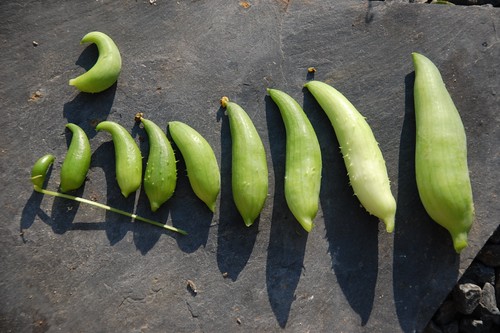Living in a forest with lots of trees on our land we do a lot of work with wood. When we have a lovely healthy trunk, like this section of a beech tree, it seems wasteful to simply chop it up for firewood although that is our major fuel need.
We've tried lots of traditional ways to get workable wood for furniture and building from trees but splitting and sawing and smoothing huge boles that weigh tons by hand needs a full team of burly lumberjacks or much more time than we have.
However commercial sawmill equipment is very expensive and not economic for the relatively small amounts of wood that we process for home use, so we've been investigating alternative ways.
Chainsaws are the dangerous but extremely useful and powerful tools that have become standard equipment for cutting down trees but they are much more difficult to use for anything like precision work, some very clever chainsaw sculptors notwithstanding. However a method has been devised to frame them and use the frame as a guide to make parallel cuts through a body of wood, which might more easily be described as making planks.
This kit of parts for a Granberg chainsaw mill came from Alaskan Mills. This was our first attempt at using it.
As part of the preparation for the work it's necessary to make the knobbly and uneven surface of your felled tree horizontal. You can buy another kit of bars to support the saw during this difficult first cut but, if you have one, a light ladder (provided it's not warped) will do the job. It simply has to hold the saw frame level for one cut and after that the trunk itself provides the bearing surface.
First the larger bumps were trimmed away so the ladder would lie fairly flat. This was freehand chainsaw work.
We held the ladder to the trunk with some plywood and screws. It's important to set the depth of the first cut to allow for the ladder frame and the ends of the screws within the wood, cutting metal with a chainsaw ruins your chain at best.
Once the ladder or frame is secured you can make the first cut. The piece of wood you remove will mostly be bark and sapwood and will end up as firewood.
Making the first cut is quite scary. Although the chainsaw is enclosed in bars and firmly held in position it still seems wrong to have it on its side and to be pushing it along a trunk.
I had to stop taking photos at this moment and hold the near end of the ladder down so that the whole thing didn't lift up with the weight of saw, frame and overhanging ladder as the cut was completed.
After the first cut you can still see an indention but the majority of the top surface is now levelled and ready to start turning into planks.
Nice and smooth, the surface is clean and will require relatively small amounts of finishing for a good appearance. Not so much positive can be said for the appearance of my thumb there.
The first plank cut was just 2" thick and has a hole in it where that indentation was still visible. I'm going to have this one and turn it into solid beech chopping boards, hoping eventually to build a small business selling natural wood products as a sideline.
We took three 3" planks but it quickly became more difficult to work as the trunk was removed and each cut was closer to the ground.
In this picture you can see the wedges that were inserted into the cuts as they were made to hold the slab up, keeping the cut level and easing the work of the chainsaw.
A final thin and narrow plank was taken before the bottom bark was sent to the fire. Now the wood has to season until it's ready to use. Apart from my slice it's currently destined to become a new workbench in a couple of years time.


